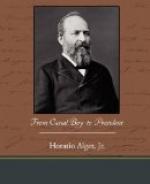I refer any of my maturer readers who may desire an abstract of the young lawyer’s masterly and convincing argument, to Major Bundy’s valuable work, which necessarily goes more deeply into such matters than the scope of my slighter work will admit. His argument was listened to with high approval by his distinguished associate counsel, and the decision of the Supreme Court was given unanimously in favor of his clients.
Surely this was a most valuable debut, and Garfield is probably the first lawyer that ever tried his first case before that august tribunal. It was a triumph, and gave him an immediate reputation and insured him a series of important cases before the same court. I have seen it stated that he was employed in seventeen cases before the Supreme Court, some of large importance, and bringing him in large fees. But for his first case he never received a cent. His clients were poor and in prison, and he was even obliged to pay for printing his own brief. His future earnings from this source, however, added materially to his income, and enabled him to install his family in that cherished home at Mentor, which has become, so familiar by name to the American people.
I can not dwell upon Garfield’s experience as a lawyer. I content myself with quoting, from a letter addressed by Garfield to his close friend, President Hinsdale, of Hiram College, the account of a case tried in Mobile, which illustrates his wonderful industry and remarkable resources.
Under date of June 18, 1877, Garfield writes “You know that my life has abounded in crises and difficult situations. This trip has been, perhaps, not a crisis, but certainly has placed me in a position of extreme difficulty. Two or three months ago, W.B. Duncan, a prominent business man in New York, retained me as his lawyer in a suit to be heard in the United States Court in Mobile, and sent me the papers in the case. I studied them, and found that they involved an important and somewhat difficult question of law, and I made myself sufficiently familiar with it, so that when Duncan telegraphed me to be in Mobile on the first Monday in June, I went with a pretty comfortable sense of my readiness to meet anybody who should be employed on the other side. But when I reached Mobile, I found there were two other suits connected, with this, and involving the ownership, sale, and complicated rights of several parties to the Mobile and Ohio Railroad.
“After two days’ skirmishing, the court ordered the three suits to be consolidated. The question I had prepared myself on passed wholly out of sight, and the whole entanglement of an insolvent railroad, twenty-five years old, and lying across four States, and costing $20,000,000, came upon us at once. There were seven lawyers in the case besides me. On one side were John A. Campbell, of New Orleans, late member of the Supreme Bench of the United States; a leading New York and a Mobile lawyer. Against us were Judge Hoadley, of Cincinnati,




